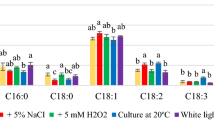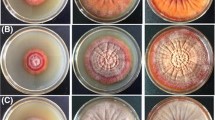Abstract
The effect of different doses of visible (Vis), ultraviolet-А (UVA), and mixed light (UVA + Vis) upon coenzyme Q10 (CoQ10) and β-carotene synthesis and biomass yield by the Sporobolomyces salmonicolor AL1, Cryptococcus albidus AS55, Cryptococcus laurentii AS56, and C. laurentii AS58 strains isolated from Antarctic samples was investigated. The β-carotene concentration in the red strain biomass increased by 52% under irradiation with 11 J/cm2 Vis, and the CoQ10 concentration rose by 37% in relation to the control quantity obtained through dark cultivation. Under irradiation with 6 J/cm2 UVA, the S. salmonicolor AL1 strain synthesized 15% more β-carotene; C. albidus AS55, 22%; C. laurentii AS56, 44%; and C. laurentii AS58, 35% in relation to the control quantity. Irradiation with a low UVА + Vis dose significantly stimulated β-carotene biosynthesis by the strains of the Cryptococcus genus (87%, 138%, and 100%), whereas S. salmonicolor AL1 increased the β-carotene content to a smaller degree (55%). Higher doses of all three irradiation types inhibited β-carotene accumulation. Vis suppressed CoQ10 biosynthesis in the Cryptococcus strains, whereas UVА and UVА + Vis inhibited it in all four strains. The S. salmonicolor AL1 strain pre-treated with 0.02 J/cm2 UVA synthesized twice as much CoQ10 and β-carotene when cultivated in the presence of Vis light in an 11-J/cm2 dose.




Similar content being viewed by others
References
Tsimako, M., Guffogg, S., Thomas-Hall, S., & Watson, K. (2002). Resistance to UVB radiation in Antarctic yeasts. Redox Report, 7, 312–314.
Libkind, D., Pérez, P., Sommaruga, R., Diéguez, M., Ferraro, M., Brizzio, S., et al. (2004). Constitutive and UV-inducible synthesis of photoprotective compounds (carotenoids and mycosporines) by freshwater yeasts. Photochemical & Photobiological Sciences, 3, 281–286.
Karentz, D. (1994). Ultraviolet tolerance mechanisms in Antarctic marine organisms. In C. Weler & P. Penhale (Eds.), UV radiation in Antarctica: Measurement and biological effects (pp. 92–110). Washington: American Geogphysical Union.
Cockell, C., & Knowland, J. (1999). Ultraviolet radiation screening compounds. Biological Review, 74, 311–345.
Krinsky, N. (1979). Carotenoid protection against oxidation. Pure and Applied Chemistry, 51, 649–660.
Phander, H. (1992). Carotenoids: an overview. Methods in Enzymology, 213, 3–13.
Edge, R., McGarvey, D., & Truscott, T. (1997). The carotenoids as anti-oxidants—a review. Journal of Photochemistry and Photobiology B: Biology, 41, 189–200.
Rock, C. (1997). Carotenoids: biology and treatment. Pharmacology and Therapeutics, 75, 185–197.
Bhosale, P., & Gadre, R. (2001). Production of β-carotene by a mutant of Rhodotorula glutinis. Applied Microbiology and Biotechnology, 55, 423–427.
Buzzini, P., & Martini, A. (1999). Production of carotenoids by strains of Rhodotorula glutinis cultured in raw materials of agro-industrial origin. Bioresource Technology, 71, 41–44.
Yurkov, M., Vustin, M., Tyaglov, B., Maksimova, I., & Sineokiy, S. (2008). Pigmented basidiomycetous yeasts are a promising source of carotenoids and ubiquinone Q10. Microbiology, 77, 1–6.
Turunen, M., Olsson, J., & Dallner, G. (2004). Metabolism and function of coenzyme Q. Biochimica et Biophysica Acta, 1660, 171–199.
Vinson, J., & Anamandla, S. (2005). Comparative topical absorption and antioxidant effectiveness of two forms of Coenzyme Q10 after a single dose and after long-term supplementation in the skin of young and middle-aged subjects. IFSCC Magazine, 8, 287–292.
Choi, J., Ryu, Y., & Seo, J. (2005). Biotechnological production and applications of coenzyme Q10. Applied Microbiology and Biotechnology, 68, 9–15.
Jap Pat (2003). No WO 056024.
Dimitrova, S., Pavlova, K., Lukanov, L., & Savova, I. (2008). Chemical composition of lipids and other lipophilic compounds from Antarctic yeast strains. Comptes Rendus de l'Academie Bulgare des Sciences, 61, 481–486.
Gimeno, E., Castellote, A., Lamuela-Raventós, R., de la Torre-Boronat, M., & López-Sabater, M. (2001). Rapid high-performance liquid chromatographic method for the simultaneous determination of retinol, α-tocopherol and β-carotene in human plasma and low-density lipoproteins. Journal of Chromatography B, 758, 315–322.
Vazquez, М. (2001). Effect of the light on carotenoid profiles of Xanthophyllomyces dendrorhous strains (formerly Phaffia rhodozyma). Food Technology and Biotechnology, 39, 23–128.
Sakaki, H., Nakanishi, T., Tada, A., Miki, W., & Komemushi, S. (2001). Activation of torularhodin production by Rhodotormla glutinis using weak white light irradiation. Journal of Bioscience and Bioengineering, 92, 294–297.
Bhosale, P. (2004). Environmental and cultural stimulants in the production of carotenoids from microorganisms. Applied Microbiology and Biotechnology, 63, 351–361.
Libkind, D., Diéguez, M., Moline, M., Perez, P., Zagarese, H., & van Broock, M. (2006). Symposium-in-print: UV effects on aquatic and coastal ecosystems occurrence of photoprotective compounds in yeasts from freshwater ecosystems of Northwestern Patagonia (Argentina). Photochemistry and Photobiology, 82, 972–980.
Schlegel, H. G. (1985). Allgemeine Mikrobiologie. Stuttgart: Georg Thieme Verlag.
Kao, Y., Saxena, C., Wang, L., Sancar, A., & Zhong, D. (2007). Femtochemistry in enzyme catalysis: DNA photolyase. Cell Biochemistry and Biophysics, 48, 32–44.
Tosi, S., Onofri, S., Brusoni, M., Zucconi, L., & Vishniac, H. (2005). Response of Antarctic soil fungi assemblages to experimental warming and reduction of UV radiation. Polar Biology, 28, 470–482.
Acknowledgements
The study was supported by Grant B-1615 from the National Fund Scientific Investigation.
Author information
Authors and Affiliations
Corresponding author
Rights and permissions
About this article
Cite this article
Dimitrova, S., Pavlova, K., Lukanov, L. et al. Synthesis of Coenzyme Q10 and β-carotene by Yeasts Isolated from Antarctic Soil and Lichen in Response to Ultraviolet and Visible Radiations. Appl Biochem Biotechnol 162, 795–804 (2010). https://doi.org/10.1007/s12010-009-8845-z
Received:
Accepted:
Published:
Issue Date:
DOI: https://doi.org/10.1007/s12010-009-8845-z




